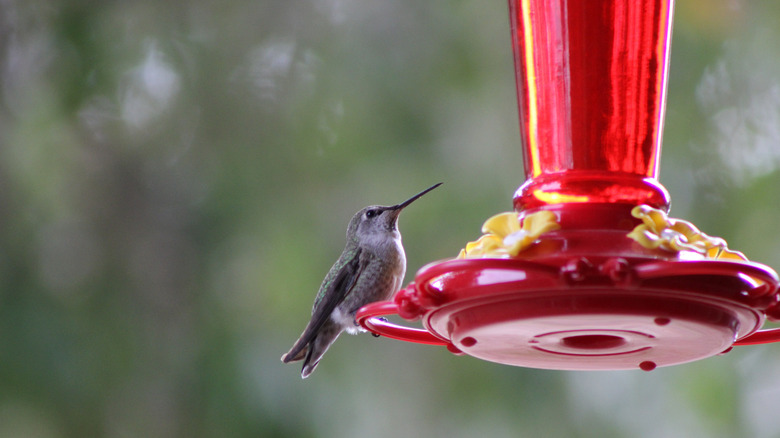Here's The Right Time To Put Out Your Hummingbird Feeder
Hummingbirds will notice if you forget to hang the feeder outside. They have a fantastic memory and sense of direction, and they can remember the position of feeders in your yard from last season — or even one from years ago. And the timing of when you put out your hummingbird feeder is important, too.
In many northern states, hanging feeders in the spring is a good idea to meet hungry hummingbirds migrating up from Mexico, while in some southern states, feeders can stay out all year round. It's important to time it correctly, however, as this can determine how helpful — or harmful — feeders can be. In USDA Hardiness Zones 4 through 6, ruby-throated hummingbirds spend their winters in warmer climates as far away as Central America. They head back for breeding season and arrive sometime in mid-April. It's best to put the feeders out before they arrive, say, in early April.
There's no real downside to having feeders up early, as they'll be a welcome food source for tired birds when few of their favorite flowers are blooming just yet. Just make sure to replace the sugar-water every day or so to prevent bacteria from growing. It's important, however, not to keep feeders up past the end of September. If you do, you'll be tempting the ruby-throated hummingbirds to delay their migration, which could make the journey more dangerous. If you don't even have a feeder and don't want to buy one, make your own hummingbird feeding tube with a glass bottle and some wire.
Track hummingbirds on a migration map
To see when hummingbirds will arrive in your area, you can track the progress of hummingbirds through this handy migration map from Hummingbird Central. For southern and southwestern states, or zones 8 through 9, it's a good idea to have hummingbird feeders out all year round. Since some will be nesting there, you can also help them by planting pussy willows (Salix discolor), the fuzzy plants in your yard that hummingbirds love for nest-building.
There are more than 360 species of hummingbirds, and they all have their favorite territories. In California, for example, you're more likely to see the black-chinned hummingbird, or Anna's hummingbird. While in states like South Carolina, you're more likely to find the broad-billed hummingbird and blue-throated mountain-gem. Allen's hummingbird, with its orange plumage, likes to spend winters in Louisiana, but then flies to Oregon for the spring and summer.
Regardless of the species of hummingbird, it's a good idea to hang your feeder near ideal resting spots, like where they like to nest, so the hummingbirds don't have to work so hard to reach it. And if you're adding more plants to your yard, learn more about the best trees for hummingbirds to nest in. Don't forget, the safest nectar to put in your feeder is a sugar-water mixture of one part sugar and four parts water.

